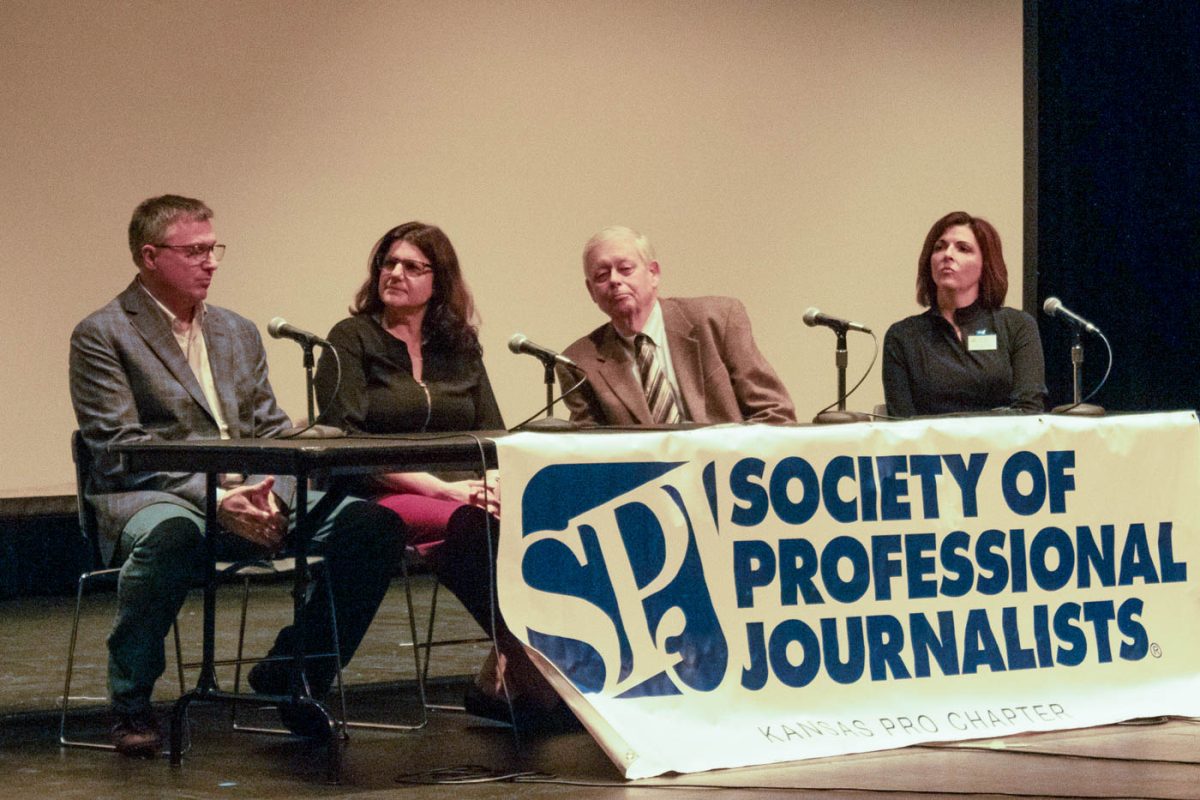Hours spent reviewing bodycam footage, conducting interviews and editing led to a documentary that draws attention to the story of the Marion County Record raid.
“Unwarranted: The Senseless Death of Journalist Joan Meyer” was shown at CAC Theatre on Feb. 1, with a panel of the creators and involved members.
The documentary explores an attack on First and Fourth Amendment rights by law enforcement on a small-town Kansas newspaper, The Marion County Record.
Last August, the Marion, Kansas, police raided the Marion County Record and the home of 98-year-old journalist Joan Meyer, who passed away a day later.
The morning before, a search warrant was issued to the Marion County Record for its legally obtained information about a local restaurant owner, Kari Newell, attempting to secure a liquor license. Newell accused the newspaper of privacy violations, leading to the raid.
The panel was composed of Eric Meyer, son of Joan and owner of the Marion County Record, documentary producers Jaime Green and Travis Heying, and Emily Bradbury, executive director of the Kansas Press Association.
Discussions ranged from behind-the-scenes information on the documentary’s creation to the legal implications for the future of search and seizure.
Behind the scenes
The documentary, produced by Green and Heying of the Wichita Eagle, features interviews and bodycam footage of the raid, centering on Joan and what happened the day before her death.
Green and Heying said they felt there was a deeper story to tell, but without being in Marion when it happened, producing a documentary seemed impossible — until bodycam footage was released to the media in early October.
“Once we obtained the body camera footage, then that’s when I knew that there’s something better than what Jaime and I could have ever hoped to have gotten by being there,” Heying said. “What Joan says is … the best reporting possible.”
Heying and Green accessed over seven and a half hours of bodycam footage from the raid, including Joan reporting live on the scene.
“This was a herculean task to go through this bodycam footage,” Eric said. “It is a daunting task, and they’ve done a masterful job.”
Green noted how rare it is to receive extensive bodycam footage.
“It was just so unusual to have this amount of bodycam footage — and to have it from so many sources,” Green said. “It’s just something unbelievable.”
Bodycam footage can be obtained via the Kansas Open Records Act. This act allows the public (and news organizations) to request and obtain copies of public records created or maintained by public agencies in Kansas.
According to state law, public agencies are not mandated to release anything considered a “criminal investigation record,” which, as of 2016, includes bodycam footage.
“Kansas is one of the most secretive states when it comes to bodycams,” said Bradbury, who defends the rights of journalists through her work at the Kansas Press Association.
Because the Marion Record was considered a victim in the case, it was able to gain access to the footage differently.
“This came through the discovery process, not through the open records process,” Eric said. “We got it because we were the victims and had a right to it.“
The documentary also featured footage from surveillance cameras in Joan’s house, which Eric noted he installed to make sure Joan was safe before he moved in with her during the pandemic.
Eric said that this combined footage helped ensure there was a “human face” in the documentary.
The raid’s impact
Jeffrey Jarman, director of the Elliott School of Communication and moderator of the panel, asked the panelists to respond to an online post that called the coverage of the raid “the most over-reported story of the decade.”
Heying said that “the opposite is true” when it comes to coverage; he has seen the same thing happen to other small newspapers around the country.
“There can’t be enough reporting about what happened in there because it’s continuing to happen elsewhere,” Heying said.
He mentioned an incident a few months after the Marion raid, where a newspaper publisher and reporter in Alabama were arrested for information they published about the local school board.
“Which tells you that our ‘over-reporting’ has not solved the problem,” Heying said. “Things like this continue to happen in places where people think that they can get away with it.”
The U.S. Press Freedom Tracker is a database that compiles “everything from arrests of journalists and the seizure of their equipment to assaults and interrogations at the U.S. border.”
At the end of 2023, Stephanie Sugars of the Freedom of the Press Foundation published an analysis of cases where journalism was “criminalized” in the past year. It found that at least 12 journalists were arrested or facing charges last year.
Eric and Green similarly highlighted the importance of continued interest in the Marion raid. Green called it “the most important story” she’s worked on in her career, and Eric said the raid itself is not unique.
“We (Eric, Joan and the Marion Record) are an insignificant part of the story,” Eric said. “The fact that this is part of a trend is what makes it interesting.”
Bradbury said that “violence against journalists has never been higher worldwide.”
“I think we as the public have to demand better, and we have to realize that we have to support our local publications,” Bradbury said.
“Unwarranted: The Senseless Death of Journalist Joan Meyer” can be found on YouTube and kansas.com.
Editor’s note: In a previous version of this story, the procurement of the bodycam footage by the Marion County Record was attributed to the Record’s right as the victim. In reality, different segments of footage were obtained via various methods.






Cheryl Kincaid • Feb 16, 2024 at 7:21 pm
How did Joan die? I’m still not sure why the Marion County newspaper was raided.